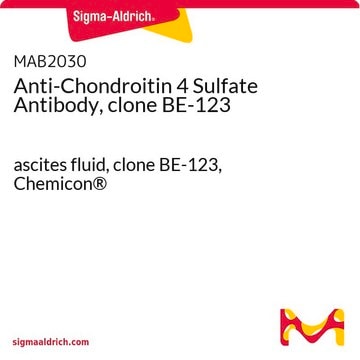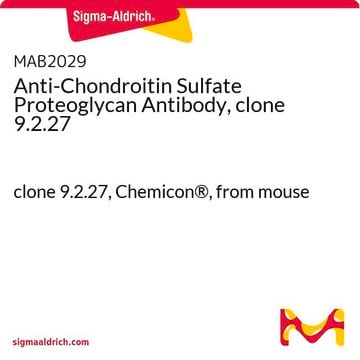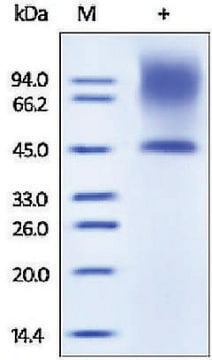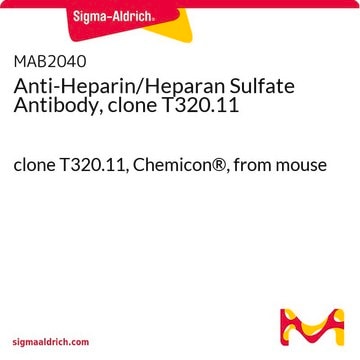추천 제품
생물학적 소스
mouse
Quality Level
항체 형태
purified from hybridoma cell culture
purified immunoglobulin
항체 생산 유형
primary antibodies
클론
CS-56, monoclonal
형태
buffered aqueous solution
종 반응성
mouse, chicken, bovine, human
포장
antibody small pack of 25 μL
농도
~1 mg/mL
기술
immunofluorescence: 2.5-5 μg/mL using bovine BMGE cells
immunohistochemistry: 2.5-5 μg/mL using heat-retrieved formalin-fixed, paraffin-embedded human colon cancer sections and Biotin/ExtrAvidin ®-Peroxidase staining system.
동형
IgM
배송 상태
dry ice
저장 온도
−20°C
타겟 번역 후 변형
unmodified
유전자 정보
human ... CSPG4(1464)
일반 설명
Monoclonal anti-chondroitin sulfate antibody, (mouse IgM isotype) is derived from the hybridoma CS56 produced by the fusion of mouse myeloma cells and splenocytes from BALB/c mice immunized with Ventral membranes of chicken gizzard fibroblasts. This antibody recognizes chondroitin sulfate containing proteoglycans (CSPG) in bovine mammary gland epithelial (BMGE) cells and also in human, chicken and mouse fibroblasts or tissues.
Chondroitin sulfate proteoglycan 4 (CSPG4) or nerve/glial antigen 2 (NG2) is encoded by the gene mapped to human chromosome 15q24.2-15q24.3. It is a growth-inhibitory chondroitin sulfate proteoglycan (CSPG) produced after spinal cord injury. It has a single glycosaminoglycan (GAG) chain. The protein belongs to the transmembrane chondroitin sulfate proteoglycans family.
Chondroitin sulfate proteoglycan 4 (CSPG4) or nerve/glial antigen 2 (NG2) is encoded by the gene mapped to human chromosome 15q24.2-15q24.3. It is a growth-inhibitory chondroitin sulfate proteoglycan (CSPG) produced after spinal cord injury. It has a single glycosaminoglycan (GAG) chain. The protein belongs to the transmembrane chondroitin sulfate proteoglycans family.
면역원
Ventral membranes of chicken gizzard fibroblasts
생화학적/생리학적 작용
Chondroitin sulfate proteoglycan 4 (CSPG4) or nerve/glial antigen 2 (NG2) stimulates the activation of integrins in dorsal root ganglion neurons. It also has a role in stimulating inflammatory cytokine expression in microglia. CSPG4 plays a vital role in brain repair. Overexpression of the gene leads to developmental delay in patients with trisomy of 15q24-qter. CSPG4 serves as a potential prognostic biomarker and therapeutic target in malignant cancer.
물리적 형태
Solution in 0.01 M phosphate buffered saline, pH 7.4, containing 15 mM sodium azide.
저장 및 안정성
for continuous use, store at 2–8°C for up to one month. For extended storage, freeze in working aliquots. Repeated freezing and thawing is not recommended. If slight turbidity occurs upon prolonged storage, clarify the solution by centrifugation. Working dilution samples should be discarded if not used within 12 hours.
기타 정보
In order to obtain best results in different techniques and preparations we recommend determining optimal working concentration by titration test.
법적 정보
ExtrAvidin is a registered trademark of Merck KGaA, Darmstadt, Germany
면책조항
Unless otherwise stated in our catalog or other company documentation accompanying the product(s), our products are intended for research use only and are not to be used for any other purpose, which includes but is not limited to, unauthorized commercial uses, in vitro diagnostic uses, ex vivo or in vivo therapeutic uses or any type of consumption or application to humans or animals.
Not finding the right product?
Try our 제품 선택기 도구.
Storage Class Code
12 - Non Combustible Liquids
WGK
WGK 1
Flash Point (°F)
Not applicable
Flash Point (°C)
Not applicable
시험 성적서(COA)
제품의 로트/배치 번호를 입력하여 시험 성적서(COA)을 검색하십시오. 로트 및 배치 번호는 제품 라벨에 있는 ‘로트’ 또는 ‘배치’라는 용어 뒤에서 찾을 수 있습니다.
이미 열람한 고객
Entrapment via synaptic-like connections between NG2 proteoglycan+ cells and dystrophic axons in the lesion plays a role in regeneration failure after spinal cord injury.
Filous AR, et al.
The Journal of Neuroscience, 34, 16369-16384 (2014)
NG2, a member of chondroitin sulfate proteoglycans family mediates the inflammatory response of activated microglia.
Gao Q, et al.
Neuroscience, 165, 386-394 (2010)
Pure duplication of the distal long arm of chromosome 15 with ebstein anomaly and clavicular anomaly.
O'Connor R, et al.
Case Reports in Genetics (2011)
Marian H Hettiaratchi et al.
Journal of controlled release : official journal of the Controlled Release Society, 297, 14-25 (2019-01-29)
Central nervous system (CNS) injuries, such as stroke and spinal cord injuries, result in the formation of a proteoglycan-rich glial scar, which acts as a barrier to axonal regrowth and limits the regenerative capacity of the CNS. Chondroitinase ABC (ChABC)
NG2/CSPG4 Proteoglycan as a Novel Prognostic Indicator and
Therapeutic Target in Malignant Cancer
Therapeutic Target in Malignant Cancer
Zhang H, et al.
Journal of stem cell research & therapy (2014)
자사의 과학자팀은 생명 과학, 재료 과학, 화학 합성, 크로마토그래피, 분석 및 기타 많은 영역을 포함한 모든 과학 분야에 경험이 있습니다..
고객지원팀으로 연락바랍니다.













